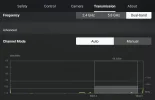My sole interest is in another legal RID free drone with no registration requirements for international travel, and no hassles domestically when out in public, where only a Trust certificate is necessary upon LEO inquiry. So, even though I have a boatload of technically compatible batteries from the
Mini 3 Pro and
Mini 4 Pro, I need to use regular M5P batteries to avoid RID. The cheapo M5P basic package with the RC-N3 is only $150 cheaper than the RC-N3 Combo package, which comes with the hub, 3 regular batteries, and the bag, so that was my choice, and, of course, use the RC
Pro 2 instead to take advantage of OS4+.
Realistically, though, for my parameters stated above, the M5P doesn't really add much to the
Mini 4 Pro, other than unwanted uncertainty about its sub 250g weight. Unlike the
Mini 4 Pro, which has 249g labelled upon its regular batteries, the M5P doesn’t specify that it is sub 250g!
Everything is marginally better, not significantly. I can't see any real difference in the 2x over digital 2x on the
Mini 4 Pro. It gains a stop for night use. It adds Lidar, but I wouldn’t depend upon it in the dark. 1” is 12.5 MP instead of 12MP and the quad bayer mode is 50MP instead of 48MP. Its flight time is a minute or two longer. It's top speed is a few mph more. Nothing really game changing here over the
Mini 4 Pro, which also has an SDK, which is completely unknown with the M5P.
No rush now, as I missed out on the original release shipment stock.













